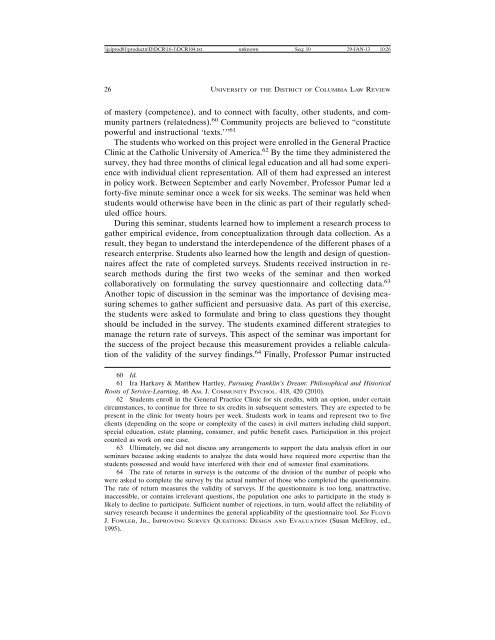volume 16, number 1 - UDC Law Review
volume 16, number 1 - UDC Law Review
volume 16, number 1 - UDC Law Review
- No tags were found...
Create successful ePaper yourself
Turn your PDF publications into a flip-book with our unique Google optimized e-Paper software.
\\jciprod01\productn\D\DCR\<strong>16</strong>-1\DCR104.txt unknown Seq: 10 29-JAN-13 10:2626 UNIVERSITY OF THE DISTRICT OF COLUMBIA LAW REVIEWof mastery (competence), and to connect with faculty, other students, and communitypartners (relatedness). 60 Community projects are believed to “constitutepowerful and instructional ‘texts.’” 61The students who worked on this project were enrolled in the General PracticeClinic at the Catholic University of America. 62 By the time they administered thesurvey, they had three months of clinical legal education and all had some experiencewith individual client representation. All of them had expressed an interestin policy work. Between September and early November, Professor Pumar led aforty-five minute seminar once a week for six weeks. The seminar was held whenstudents would otherwise have been in the clinic as part of their regularly scheduledoffice hours.During this seminar, students learned how to implement a research process togather empirical evidence, from conceptualization through data collection. As aresult, they began to understand the interdependence of the different phases of aresearch enterprise. Students also learned how the length and design of questionnairesaffect the rate of completed surveys. Students received instruction in researchmethods during the first two weeks of the seminar and then workedcollaboratively on formulating the survey questionnaire and collecting data. 63Another topic of discussion in the seminar was the importance of devising measuringschemes to gather sufficient and persuasive data. As part of this exercise,the students were asked to formulate and bring to class questions they thoughtshould be included in the survey. The students examined different strategies tomanage the return rate of surveys. This aspect of the seminar was important forthe success of the project because this measurement provides a reliable calculationof the validity of the survey findings. 64 Finally, Professor Pumar instructed60 Id.61 Ira Harkavy & Matthew Hartley, Pursuing Franklin’s Dream: Philosophical and HistoricalRoots of Service-Learning, 46 AM. J. COMMUNITY PSYCHOL. 418, 420 (2010).62 Students enroll in the General Practice Clinic for six credits, with an option, under certaincircumstances, to continue for three to six credits in subsequent semesters. They are expected to bepresent in the clinic for twenty hours per week. Students work in teams and represent two to fiveclients (depending on the scope or complexity of the cases) in civil matters including child support,special education, estate planning, consumer, and public benefit cases. Participation in this projectcounted as work on one case.63 Ultimately, we did not discuss any arrangements to support the data analysis effort in ourseminars because asking students to analyze the data would have required more expertise than thestudents possessed and would have interfered with their end of semester final examinations.64 The rate of returns in surveys is the outcome of the division of the <strong>number</strong> of people whowere asked to complete the survey by the actual <strong>number</strong> of those who completed the questionnaire.The rate of return measures the validity of surveys. If the questionnaire is too long, unattractive,inaccessible, or contains irrelevant questions, the population one asks to participate in the study islikely to decline to participate. Sufficient <strong>number</strong> of rejections, in turn, would affect the reliability ofsurvey research because it undermines the general applicability of the questionnaire tool. See FLOYDJ. FOWLER, JR., IMPROVING SURVEY QUESTIONS: DESIGN AND EVALUATION (Susan McElroy, ed.,1995).














